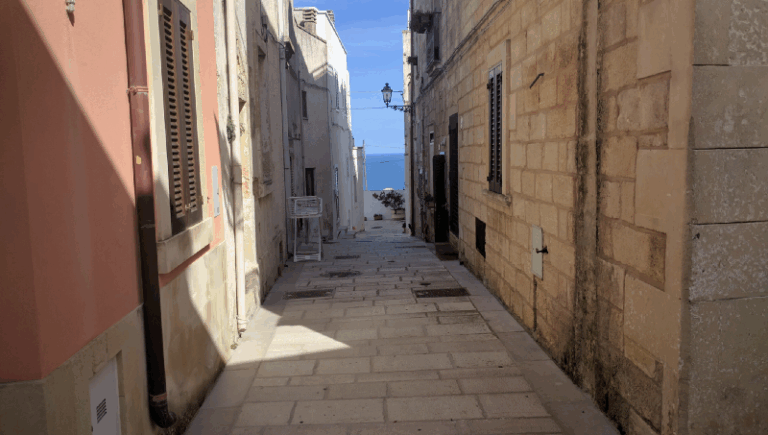Physical Address
304 North Cardinal St.
Dorchester Center, MA 02124
Physical Address
304 North Cardinal St.
Dorchester Center, MA 02124

There is always the lurking suspicion that great urbanism is a museum piece, something we cannot recreate. We have to console ourselves with guarding what’s left. Even then, some feel it unfit for ‘modern life,’ that humans cannot live as their recent ancestors had. Urbanists tend to celebrate cities and spaces of great renown, which makes remaking our own little corner of the world seem futile. I spent a year living in Europe–visiting Belgium, Italy, Spain and France, among other places–and found that the best places were not the big cities, but old villages, often very wealthy in times past. And it’s easy to miss what’s special about these quiet gems: the little streets and paths within them that people call home. A newly-built mall in Leuca, Italy showcases an older design sensibility A bike tour led me to several towns in southern Italy—among them, Castro was my favorite aesthetically, with warm, immaculate streets around the center that were nonetheless devoid of many people. Castro, Italy Castro, Italy Long before going to Europe, I had seen this meme photo: Lo and behold, one such camera appeared right above where I parked my bike. But overall, Bari’s old city was my favorite, with all the life coarsing through its streets. Families would open their doors and put out folding chairs in the streets. They made the streets their living room, while literally airing their dirty laundry in the rafters between buildings. Bari, Italy A quiet street in Leuven, Belgium—perhaps my favorite of all A Flemish parking lot—the Grand Beguinage, Leuven, Belgium Reims, France In Reims, I got to tour some underground cellars that formerly stored champagne. With cool temperatures, high ceilings and lush moss lining the walls, I thought—I’d love to live here! Should people be banned from […]
In America, there is an almost stifling consensus among pro-urban types—trains are good, trains are right, trains work. Trains have marked the upward surge of mankind—trains clarify and capture the essence of the American spirit. “Just look at Europe!” Yes, let’s look at Europe. What you’ll find is a startling change—Europeans are embracing the conventional coach bus for trips once exclusively the province of trains and private automobiles. The Economist has called it a ‘Revolution on Wheels.’ The consultancy Oliver Wyman titled their report ‘Hit by a Bus: European Rail.’ Why did this happen? Trains were supposed to be the future, and buses a shoddy relic of the past. Up until a few years ago, it was illegal to run intercity buses in Germany and France, among others, to protect their state-owned train system from competition. When Germany relaxed this ban in early 2013, suddenly a host of newcomers sprang up to serve the demand for travel between cities. By year’s end, weekly bus journeys in Germany had increased by 230%. The industry went through a cycle of intense competition between several players, followed by consolidation into a few big rivals. Just this summer, the biggest player in Germany, Flixbus, acquired the continental operations of Megabus, a big player in the United States, as well as domestic operations by Germany’s Postbus. During the summer of 2015, France followed with its own deregulation to allow intercity buses. The Economist writes that “France had only 100,000 intercity coach passengers in all of 2014, but saw 250,000 in the single month from mid-August.” Italy, Sweden and Finland have also deregulated their markets in recent years. Buses have one premier appeal—they are cheap. For the 140-mile trip I took this weekend from Brussels to Cologne, tickets were $10, while a train ride was $44. Browsing […]
Brussels, Belgium–I had recently moved from Los Angeles, my home of twenty years, to Brussels. It would be my first time living in a traditional city since becoming interested in urban design. So I was constantly looking for little urban insights and pleasures on the ground. For instance, I immediately noticed that housing prices here are roughly half of what I encountered in Los Angeles. Within a few weeks of my arrival, the bombings of Brussels occurred. The atrocity raises some interesting questions in regards to urbanism—are there certain urban designs that can prevent or discourage terrorism? Should the threat of terrorism influence the design of our cities? How would it? While terrorism may leave us shocked and breathless, it’s worth remembering that traffic deaths greatly outnumber deaths due to terrorism. In sheer numbers of lives lost and saved, cars are the bigger culprit. Terrorism, for its part, exacts a great toll paid in fear as well as loss of life and limb. What makes a city resilient in the face of terrorism? Walking The more ways one can move about the city, the more resilient it will be in the face of crisis. But, these options are not equal; cars are big compared to the space available for them—if everyone were to drive, no one would move. Here, man in his humblest form is king—we are always ready to walk, several miles if need be, without the aid of any special operator or infrastructure. Density and proximity ensure walking home is a reasonable or even routine affair. Walking loses its appeal, however, as travel distances increase, especially for the less physically able among us. And as much as walkability is ideal, many cities are just not suited for it, in their current state. Work is too far to reach via […]